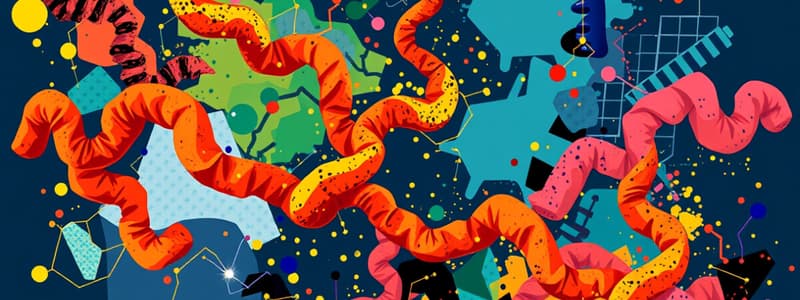Podcast
Questions and Answers
What is the primary structure of a protein?
What is the primary structure of a protein?
- The connections between multiple polypeptide chains
- The three-dimensional orientation of secondary structures
- The sequence of amino acids (correct)
- The regularly repeating elements within a protein
Which structure is characterized by hydrogen bonds between the backbone of a protein?
Which structure is characterized by hydrogen bonds between the backbone of a protein?
- Quaternary structure
- Tertiary structure
- Secondary structure (correct)
- Primary structure
What defines the tertiary structure of a protein?
What defines the tertiary structure of a protein?
The three-dimensional orientation of all the different secondary structures and the turns and loops that connect them.
What is the quaternary structure of a protein?
What is the quaternary structure of a protein?
Describe the features of an amino acid.
Describe the features of an amino acid.
Which of the following amino acids has nonpolar, aliphatic R groups?
Which of the following amino acids has nonpolar, aliphatic R groups?
What type of bond forms between the side chains in salt bridges?
What type of bond forms between the side chains in salt bridges?
What are beta-sheets and what characterizes them?
What are beta-sheets and what characterizes them?
Define and describe protein domains.
Define and describe protein domains.
Describe the role of hydrogen bonds in protein shape.
Describe the role of hydrogen bonds in protein shape.
What type of R group does Glutamate have?
What type of R group does Glutamate have?
Flashcards are hidden until you start studying
Study Notes
Protein Structure
- Primary structure consists of a linear sequence of amino acids in a polypeptide chain.
- Secondary structure involves regular patterns formed by hydrogen bonds between backbone atoms, creating elements like alpha helices and beta sheets.
- Tertiary structure represents the three-dimensional conformation of a protein, driven by interactions among secondary structure components and side chains.
- Quaternary structure refers to the assembly of multiple polypeptide chains into a functional protein complex, often stabilized by hydrophobic interactions.
Amino Acid Structure
- Each amino acid has an N-terminus (amino group) and a C-terminus (carboxylic acid group).
- Peptide bonds formed between amino acids exhibit planarity and no rotational freedom, while other bonds allow for rotation.
Grouping of Amino Acids
- Amino acids are classified based on the properties of their side chains, influencing protein structure and function.
Nonpolar, Aliphatic Amino Acids
- Glycine: Simplest, allows flexibility in proteins.
- Alanine: Commonly found, maintains nonpolar characteristics.
- Proline: Unique cyclic structure, introduces rigidity.
- Leucine: Important in protein structures, especially in hydrophobic regions.
- Methionine: Contains sulfur, often initiates protein synthesis.
Polar, Uncharged Amino Acids
- Serine: Involved in enzyme active sites; can participate in disulfide bonds.
- Cysteine: Contains sulfur, forms disulfide bonds that stabilize protein structures.
- Glutamine: Acts as an amide donation site for nitrogen; key for protein function.
Polar, Charged Amino Acids
- Glutamate: Negatively charged at physiological pH, contributes to acidity.
- Lysine: Positively charged, plays a significant role in enzymatic activity and positive interactions.
Nonpolar, Aromatic Amino Acid
- Phenylalanine: Hydrophobic side chain; important for protein stabilization through aromatic interactions.
Secondary Structure Features
- Alpha helices: Formed by hydrogen bonds, typically feature small, hydrophobic side chains, and consist of 3.6 residues per turn; proline can disrupt these formations.
- Beta sheets: Comprise at least two peptide strands stacked together with hydrogen bond interactions, can be antiparallel or parallel in orientation.
Protein Domains
- Domains are structurally independent units within a protein, often associated with specific functional roles, such as enzymatic or regulatory tasks, and consist of clusters of secondary structure elements.
Interactions in Protein Shape
- Salt bridges: Ionic bonds form between oppositely charged side chains, stabilizing protein structure.
- Hydrogen bonds: Develop between polar side chains, backbone, and surrounding water; crucial in maintaining protein structure.
- Hydrophobic interactions: Involve weak Van der Waals forces and are more robust hydrogen bonds; hydrophobic regions tend to cluster inward, driven by the exclusion of water.
Studying That Suits You
Use AI to generate personalized quizzes and flashcards to suit your learning preferences.




